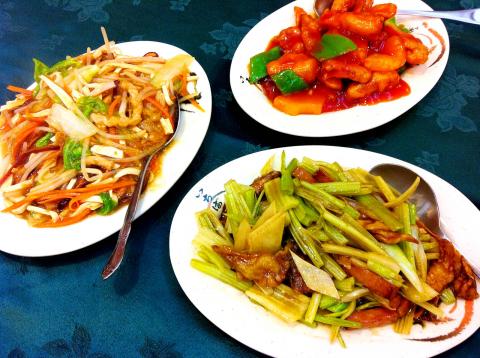A recent visit to King Join, an upscale vegetarian restaurant that serves fancy Beijing-style cuisine, (see the Feb. 18, 2011, edition of the Taipei Times), left me thinking: Sure, these quaint, refined recipes of the imperial court were nice and all, but what about some home-cooked grub for the people?
Enter Jingyuan Beiping Vegetarian Restaurant (京園北平素食館), which serves non-meat versions of standard northern dishes, among other favorites.
Located near Hsingtien Temple (行天宮), Jingyuan is the cleaner looking, and perhaps a tad healthier, version of your neighborhood Beijing/Beiping/(choose your favorite old name for the Chinese capital) “palace” or family-style restaurant.

Photo: David Chen, Taipei Times
It’s easy to forget you’re about to have a vegetarian meal glancing through Jingyuan’s nine-page menu. The selection is a long list of familiar dishes: an assortment of dumplings both steamed and fried, zhajiang mian, or fried sauce noodles (炸醬麵, NT$80), mapo tofu (麻婆豆腐, NT$138), kung pao chicken (宮保雞丁, NT$168), sweet and sour pork chops (糖醋排骨, NT$188). There’s even the basil-infused sanbeiji, or three cup chicken (三杯雞, NT$208).
Jingyuan uses various kinds of tofu and seitan (which is made out of wheat gluten) as meat substitutes, and like many places in Taiwan that cater to Buddhist vegetarian diets, the restaurant doesn’t cook with garlic, onion, shallot or leek.
This fact made the ganbian sijidou, or stir-fried green beans (乾扁四季豆, NT$168), seem even more impressive for its strong and savory flavor. Bits of smoked tofu mimicked minced meat, while zesty notes came from chopped day lily stems (金針筍), also called biyusun, or jade bamboo shoots (碧玉筍), a garlic substitute that looks like green onion. The dish made my dining companion pause after taking her first bite. “Wait. Are you sure this is vegetarian?” she asked.
You won’t ask that question about Jingyuan’s sweet and sour pork (糖醋里肌, NT$188), but it’s still very much worth trying for its sweet and tangy glaze and deep-fried goodness. Another house recommendation is the Hakka stir-fry (客家小炒, NT$188), which has a peppery bite and is chock-full of textures, from the crispness of the julienned celery to the tender bites of tofu.
The combination vegetable stir-fry (炒合菜, NT$168) was much more appetizing than it appeared and turned out to be one of our favorites. It looked like sweet-and-sour soup (酸辣湯), but without the soup. The ingredients were indeed similar: cabbage, carrot, rice noodles and tofu. It was also less greasy than the other stir-fry dishes.
Have the above items with rice or the fried bread (銀絲卷, NT$30 per piece), a mantou with a crispy, slightly sweet golden crust.
Jingyuan’s xiaolongbao (小籠包, NT$120 for a basket of 10) is not going to put Din Tai Fung out of business anytime soon, but these dumplings, filled with rice noodles, finely chopped tofu and vegetable greens, were refined in their own way. I had high hopes for the vegetarian potstickers (素食鍋貼, NT$80 for eight pieces), which were cooked to a perfect golden brown on the bottom, but the all-cabbage filling didn’t work — they fell apart after the first bite.
A few other northern classics on the menu include the xianbing, or meat pie (餡餅), and the xiangchun rolls (香椿卷餅, NT$60), a vegetarian version of fried scallion roll with beef (牛肉捲餅).
It’s hard to beat the real thing, but Jingyuan Beiping Vegetarian Restaurant comes pretty close, and the restaurant offers a nice upscale alternative to Taipei’s ubiquitous vegetarian buffets.

April 14 to April 20 In March 1947, Sising Katadrepan urged the government to drop the “high mountain people” (高山族) designation for Indigenous Taiwanese and refer to them as “Taiwan people” (台灣族). He considered the term derogatory, arguing that it made them sound like animals. The Taiwan Provincial Government agreed to stop using the term, stating that Indigenous Taiwanese suffered all sorts of discrimination and oppression under the Japanese and were forced to live in the mountains as outsiders to society. Now, under the new regime, they would be seen as equals, thus they should be henceforth

Last week, the the National Immigration Agency (NIA) told the legislature that more than 10,000 naturalized Taiwanese citizens from the People’s Republic of China (PRC) risked having their citizenship revoked if they failed to provide proof that they had renounced their Chinese household registration within the next three months. Renunciation is required under the Act Governing Relations Between the People of the Taiwan Area and the Mainland Area (臺灣地區與大陸地區人民關係條例), as amended in 2004, though it was only a legal requirement after 2000. Prior to that, it had been only an administrative requirement since the Nationality Act (國籍法) was established in

Three big changes have transformed the landscape of Taiwan’s local patronage factions: Increasing Democratic Progressive Party (DPP) involvement, rising new factions and the Chinese Nationalist Party’s (KMT) significantly weakened control. GREEN FACTIONS It is said that “south of the Zhuoshui River (濁水溪), there is no blue-green divide,” meaning that from Yunlin County south there is no difference between KMT and DPP politicians. This is not always true, but there is more than a grain of truth to it. Traditionally, DPP factions are viewed as national entities, with their primary function to secure plum positions in the party and government. This is not unusual

US President Donald Trump’s bid to take back control of the Panama Canal has put his counterpart Jose Raul Mulino in a difficult position and revived fears in the Central American country that US military bases will return. After Trump vowed to reclaim the interoceanic waterway from Chinese influence, US Defense Secretary Pete Hegseth signed an agreement with the Mulino administration last week for the US to deploy troops in areas adjacent to the canal. For more than two decades, after handing over control of the strategically vital waterway to Panama in 1999 and dismantling the bases that protected it, Washington has